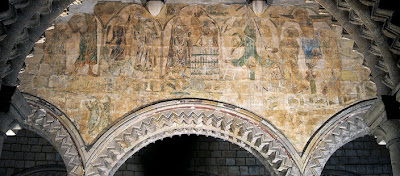Like I had mentioned before Italy has a lot to offer and spending just one day there would definitely not have been enough. There is just so much to do! I wanted to make the best out of this trip for me and my family so our days were jammed packed with tons of sites to go and see!
The first day like I said (or noted in my previous blogs) consisted of us getting settled in to our new hotel as well as checking out the Colosseum and the Trevi Fountain--and the added bonus of the Barberini Fountain. It was really nice to have a bit of free time in the evening being that we have already been to several other prior to coming to Rome. However, this free time was sure to not last for long!
 |
| Outside the Vatican Museum |
The Vatican City
 |
| Wall hangings by Raphael |
Once we arrived to our destination we were overwhelmed by the masses of people waiting in line. It was only 9:00am! That's when we decided the best idea would be to give up some cash to join a tour group. I think this might have been one of the best decisions we made. The tour group was able to go ahead of the lines AND we got to learn a lot of detailed information about the Vatican City and the Sistine Chapel alike.
Our tour guide that took us around was from Boston and was really sassy.  |
| The crazy loud Italian tour guide in the left corner |
She was constantly yelling at some Italian tour guide who was being rather obnoxiously loud when he spoke. It was quite hilarious actually. For the next hour and half we were guided, toured and informed about all the things in the Vatican --she was wonderful, so brilliant and smart. There was so much to see from his gardens to the Sistine chapel I was constantly looking around to make sure I caught as much of the artwork and history as possible!
So I hope it doesn't sound to cliche but I was mainly excited to view the Sistine Chapel. The line to the room itself was rather long and I was a bit disappointed to learn that no pictures were allowed to be taken in the room. Well at least that's what it said. Upon walking into this glorious room I was overwhelmed. There were so many people packed into this room. It was full of talking and flashes from those cameras which were not to be used.
Our guide gave us fifteen minutes to walk around the room and take it all in. I was quite happy with this because I wanted to be able to experience it on my own and just reflect on the masterpiece that was in front of my very eyes. I know I have said this millions of times, but seeing pictures and reading about it in art history books does not do it justice. Actually seeing it in person makes the world of difference. It is so overwhelming, the figures, the detail, the massive size are enough to make one speechless. I never once thought I would personally be able to see the work of the greatest Renaissance artists and their frescoes. Michelangelo, Raphael, Bernini and Botticelli to name a few all have their place in this one location. I was standing where these great artists have all left their mark.
 |
| Creation of Adam |
 |
| Last Judgment |
Overall this was my favorite place we toured. I got to see and learn so much. I love our tour guide and how helpful and knowledgeable she was. I learned that those tours can be hit or miss, and we luckily got a good one that day. Money well spent. The only thing that left me on the fence about this room was the photography portion. While I was extremely happy that I had gotten to take a few pictures I feel as though that was the downfall of this room. I saw people taking picture with flash, and immediately got upset. I understand that people may not know this damages the pigments, but it is still extremely unnerving. Not only that, but the pictures and massive quantities taken I believe make this chapel have a different stigma. I think part of the awe of this room besides just the magnificent painting is the fact that you are not supposed to take pictures and it is sacred.
As we were leaving the Sistine Chapel I was relieved to see that the guards were buckling down on the volume of those in the room as well as the photography. Some things need to be protected, and I myself contributed to part of the problem and feel rather guilty of snapping some photographs.





















































